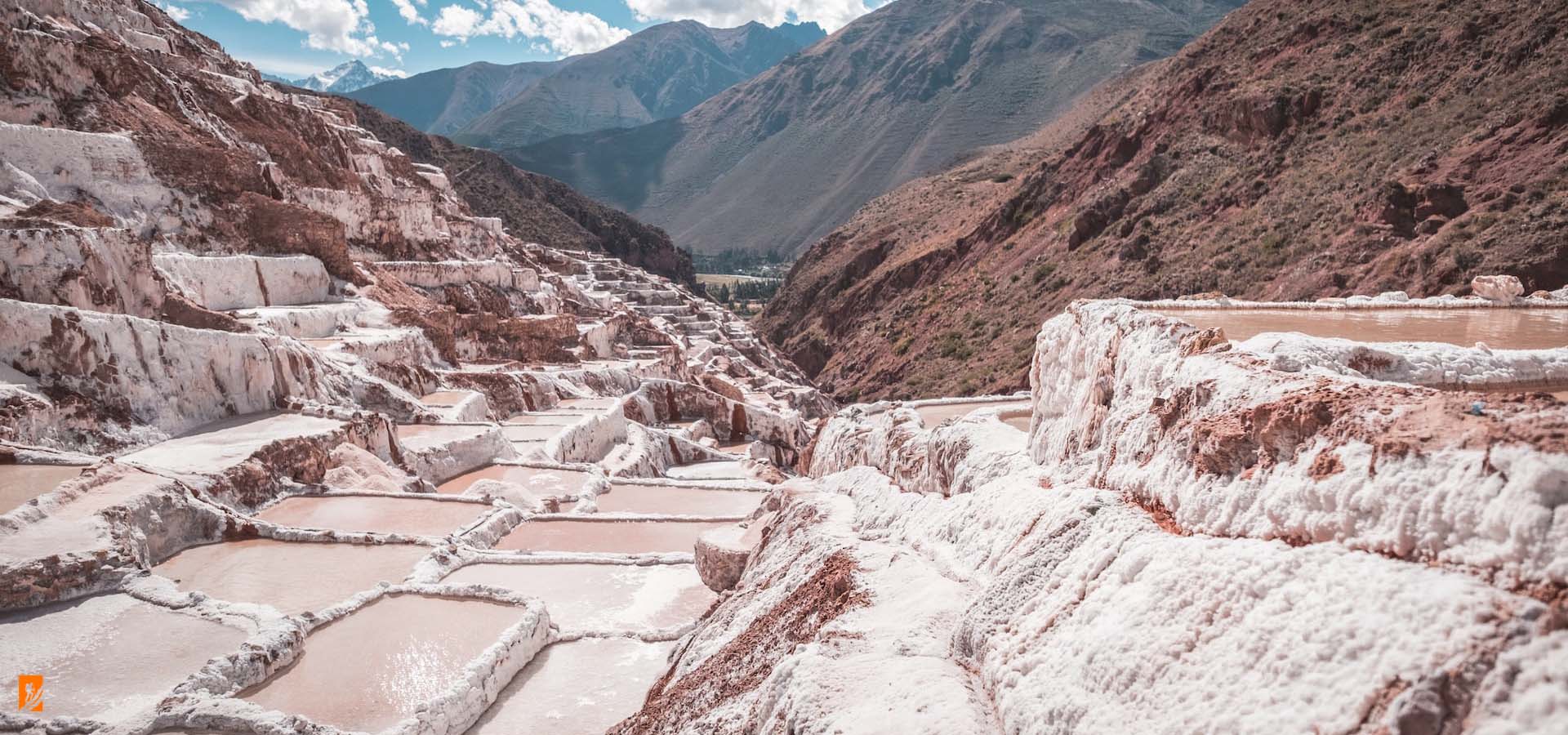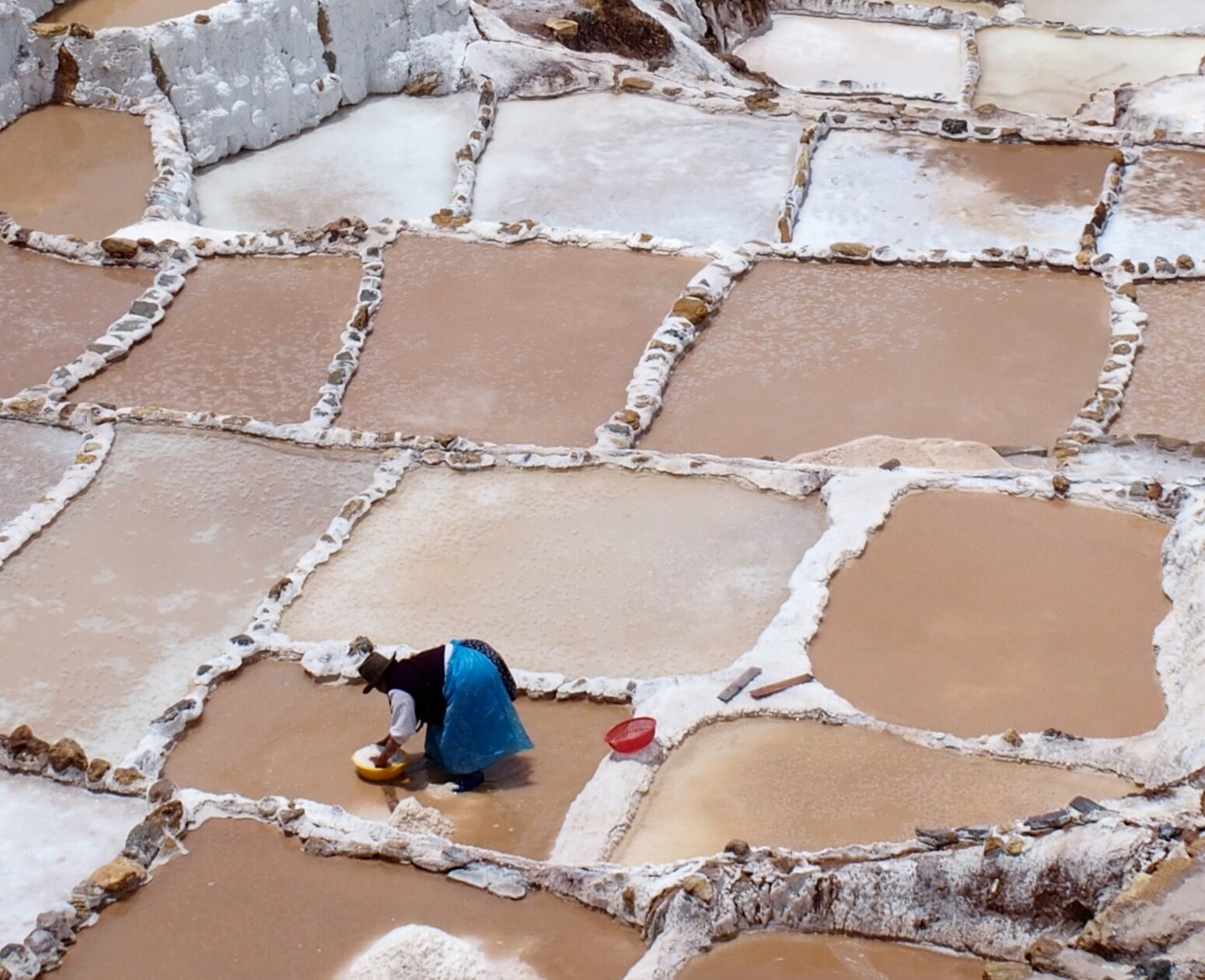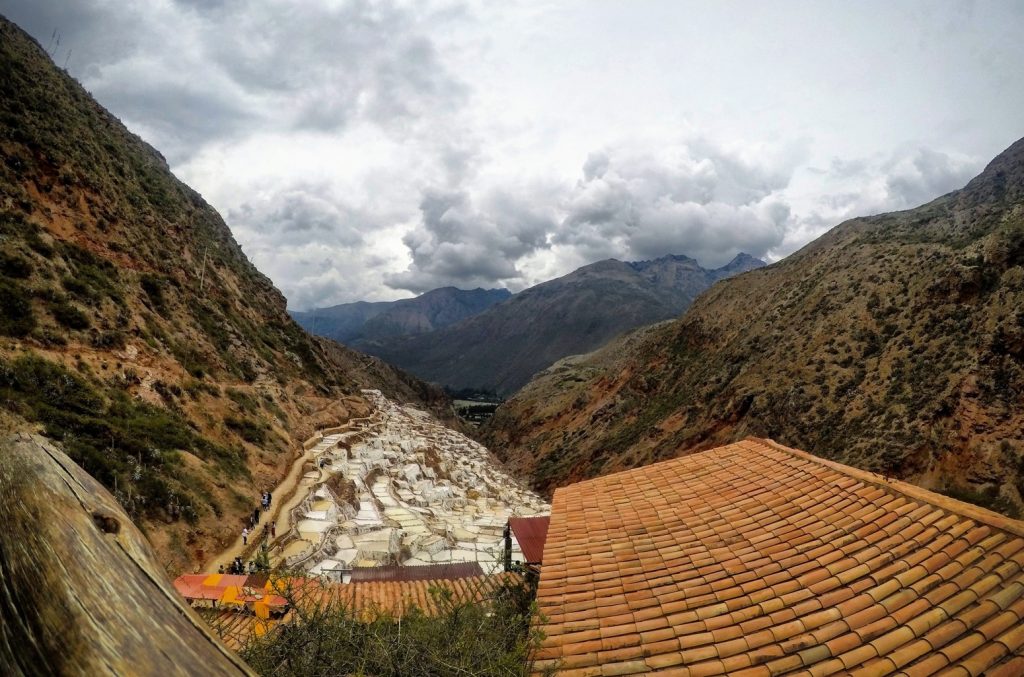Written by Sam Corporations February 13, 2023

The Inca salt mines in the Sacred Valley is an essential part of your exploration of the Inca Heartland in Peru. Indeed there are many ruins to visit and mountainsides to trek, but one intriguing sight that should not go unnoticed are the ancient salt pans, known as Salineras de Maras. Strategically dug into the mountainside, thousands of shallow pools filled with salt water eventually evaporate and leave behind the crystallized salt. This process has been practiced for more than 500 years.
The salt pans of Maras have been used for the past five centuries to mine salt in the Sacred Valley.
You might be wondering how large amounts of salt deposits ended up in the middle of the Andes Mountains. Though the salt pans themselves are man-made, the water that is channeled through them comes from a subterranean natural spring, which is mixed with salt deposits from prehistoric salt lakes. Over millions of years, tectonic plate movement has buried the deposits deep beneath the mountains. The salt is accessible from an underground water flow of brine – a mixture of salt and water – that bubbles up in a natural spring near the small town of Maras.

It’s believed that the salt pans were originally constructed by the Wari civilization, which predates the Inca. However, the Inca saw the economic opportunity in harvesting the salt of Maras and expanded the salt pans further up the mountainside. The salt crystals are carefully scraped from the sides of the pools as the brine evaporates.
The salt is mined through the evaporation of the brine that is channeled into the pans. When the water evaporates, members of the local communities carefully scrape the salt crystals from the earthen surfaces. When all of the crystals are removed, the pan is filled with the salt water again – a process that has been practiced since before the time of the Inca.

The local community has exclusive mining rights to the salt pans near Maras. Today there are over 6,000 salt pans near Maras, and each one is no more than 13 square feet and less than 1 foot deep. Each pan is owned and mined by a local family of the Maras community. The salt is collected and sold in local shops or nearby towns.
The salt pans are also an interesting attraction for people visiting the Sacred Valley. Travelers can explore the salt pans on a guided tour and see captivating vistas and access points of the site for 10 soles (about $3) entrance fee. Afterward, you can buy some of the Andean salt as a souvenir.
If you are planning a trip to Peru, you will surely wonder when is the best time to “have the experience” among these ancient pools. Well, normally, by consensus and advice of already professional travelers, it is usually recommended to travel during the dry season of Cusco (between May and October).
The dry season represents a much more pleasant climate where you will enjoy clear skies and bursts of sunshine, making the water evaporate to manifest the brilliant snowy color. The dry season is also beneficial for horseback riding. In addition, you can ride ATVs or hike around the site and appreciate the views better. Conveniently, it is the same recommendation for those who wish to visit Machu Picchu.
On the other hand, during the rainy season that occurs from December to March, the Maras Salt Mines pools turn a more brown and earthy color. To say nothing of heavy rains and thunders, which can make muddy routes and offer opaque photos of the salt pools. This is not the recommended time to visit.
There are many ways to experience the majestic salt mines of Maras. Whether you want to go at a leisurely pace with an expert guide or zoom across the surroundings by ATV, there’s a tour waiting for you.
You can take a general walking tour of the site either in private or in a group with an expert guide. Savor the unique beauty of the Andean landscapes and enjoy plenty of photo opportunities. Many Sacred Valley tours also include Pisac, Moray and Ollantaytambo archaeological site in a day.
See the detailed itienrary here!
For a touch of adventure, hop on a 4-wheel ATV (quad bike) and zoom through the Andean countryside. Make stops at the Maras salt pans and the Moray archaeological site. Security briefing included at the start of the tour.
Trot, prance, and gallop by horseback through the picture perfect scenery of the Sacred Valley. You’ll make a stop at many scenic viewpoints, with the highlight being the otherworldly Maras salt pans.
The dirt trails traversing the open landscapes of the Sacred Valley are an outdoor lover’s dream. One of the most exciting routes goes to Maras and Moray. The first stop is Moray followed shortly after by Maras.
Hiking Maras
There’s nothing quite like traversing the valley by foot, taking in the sights, discovering little known gems, and getting some cardio all at the same time. A half day hike makes stops at the Moray archaeological site and the ancient Inca Maras salt ponds.
Salt Water in the Andes.
History of Maras.
The Significance Today.
THE BEST TIME TO GO THERE
Best Tour options to visit the Salt mines
COMPLETE SACRED VALLEY TOUR
ATV MARAS
HORSEBACK RIDING
MOUNTAIN BIKING
Quality
Contact our travel advisors to plan the most complete trip of your life.
Simplified ease of communication, text us on WhatsApp, email or call us.
Our guides are local and have vast knowledge in Peruvian culture and history.
100% local company. Development and environmental sustainability
Our groups never exceed 10 people, giving you an unforgettable experience
Discover an exceptional journey where perfection meets adventure.